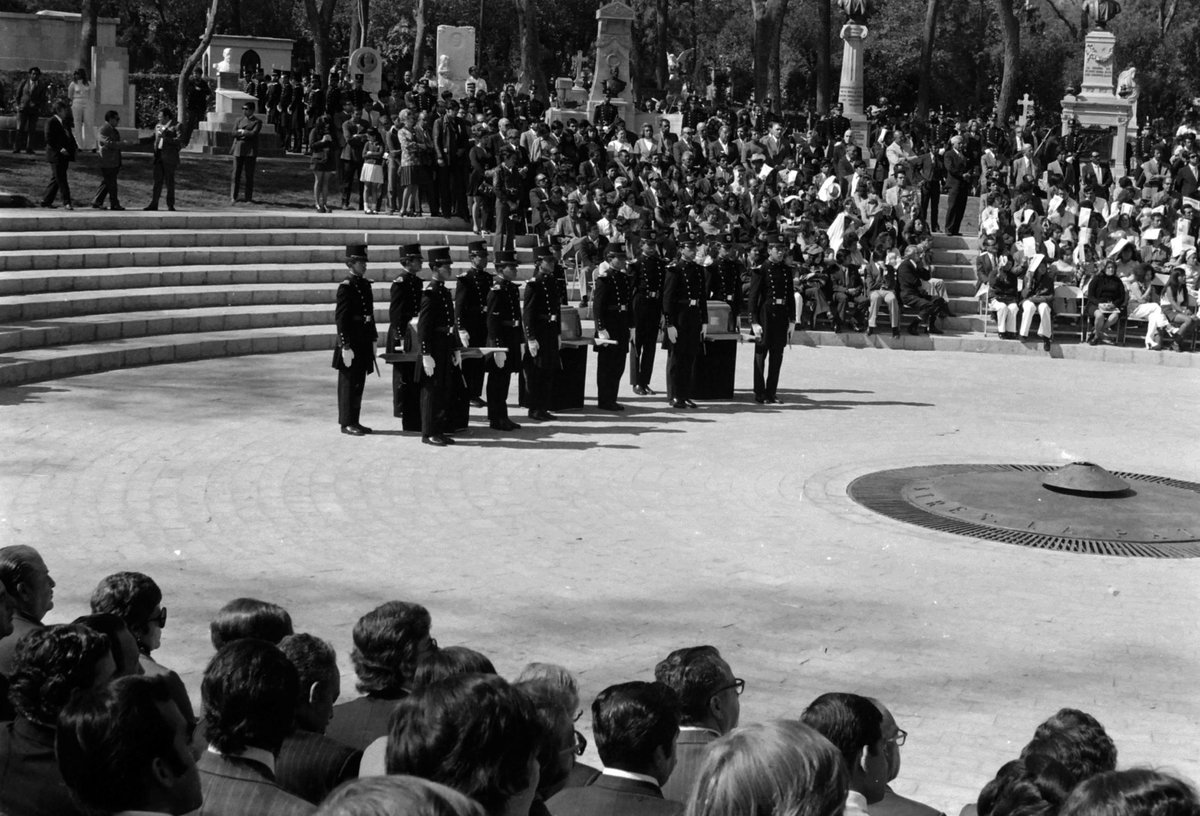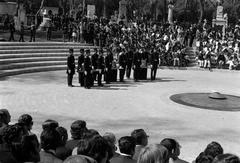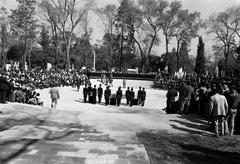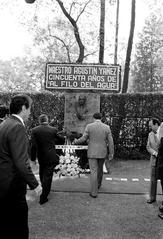
Rotonda de las Personas Ilustres, Mexico City: Visiting Hours, Tickets, and Historical Sites Guide
Date: 15/06/2025
Introduction
Nestled in the Panteón Civil de Dolores, the Rotonda de las Personas Ilustres is a circular memorial that stands as a powerful tribute to Mexico’s most esteemed citizens. Established in 1872 by presidential decree under Sebastián Lerdo de Tejada, it was originally known as the Rotonda de los Hombres Ilustres, reflecting the gender norms of its era. The site was renamed in 2003 to the Rotonda de las Personas Ilustres to embrace inclusivity and gender equality, honoring both men and women who have made extraordinary contributions to Mexican society in fields such as politics, arts, science, education, and social activism (Explorando México; SEGOB).
More than a burial ground, the Rotonda serves as a living monument—its architecture, artistry, and symbolism offering a window into the evolving narrative of Mexico’s national identity. Home to over 100 notable figures, including Nobel laureates, revolutionary leaders, and cultural icons, the Rotonda provides a unique opportunity to engage with Mexico’s history and heritage (Mexico City Government; The Creative Adventurer).
This guide covers everything you need to plan your visit: history, visiting hours, ticketing, accessibility, architectural highlights, travel tips, and FAQs—enabling you to make the most of your experience at this iconic Mexico City landmark.
Table of Contents
- Introduction
- History and Evolution
- Criteria for Interment and Selection Process
- Notable Figures
- Architecture and Symbolism
- Visiting Information: Hours, Tickets, and Accessibility
- Visitor Tips and Nearby Attractions
- Frequently Asked Questions (FAQ)
- Conclusion
- References
History and Evolution
Origins and Significance
The Rotonda de las Personas Ilustres was established in 1872 as a dedicated section within the Panteón Civil de Dolores to honor Mexicans who have made significant contributions to the nation’s development. Its foundation reflected a broader 19th-century trend of memorializing national heroes and intellectuals, reinforcing ideals of nationhood and collective memory (Explorando México). The site’s first interment was Pedro Letechipía, recognized for his military valor during the French Intervention.
Transition to Inclusivity
For over a century, the Rotonda was officially reserved for men, but in 2003, its name and mission were updated to include distinguished women. This milestone reflected Mexico’s evolving values and commitment to recognizing the diverse contributions of all its citizens (SEGOB).
Criteria for Interment and Selection Process
Individuals are selected for their extraordinary impact on Mexican society in fields including politics, science, literature, the arts, and social advocacy. Nominations are reviewed by a committee comprising representatives from government, academia, and cultural organizations, ensuring that honorees reflect the nation’s collective values and historical progress.
Notable Figures
Over 100 individuals rest in the Rotonda as of June 2025, representing a cross-section of Mexican excellence (Explorando México). Highlights include:
- Amado Nervo: Modernist poet and diplomat.
- Leona Vicario: Independence heroine and one of the first women honored.
- Octavio Paz: Nobel Prize-winning poet and essayist.
- Diego Rivera, David Alfaro Siqueiros, José Clemente Orozco: Legendary muralists.
- Dolores del Río: Golden Age film actress.
- Mario Moreno “Cantinflas”: Iconic comedian.
- Guillermo González Camarena: Color TV pioneer.
- Rosario Castellanos: Writer and advocate for women and indigenous communities.
- Agustín Lara, Carlos Chávez: Renowned composers.
- Ricardo Flores Magón: Revolutionary journalist.
- Virginia Fábregas: Theater and film pioneer.
This diversity underscores the Rotonda’s role as a pantheon for political leaders, artists, scientists, educators, and activists.
Architecture and Symbolism
Site Layout
The Rotonda’s circular garden symbolizes unity, equality, and the cyclical nature of memory. Tombs and monuments are arranged in a ring around a central grassy area, creating a contemplative atmosphere. The central votive lamp is a perpetual symbol of remembrance (Mexico City Government; The Creative Adventurer).
Artistic Features
The Rotonda blends funerary art and landscape design. Monuments are crafted from stone, marble, metal, or Talavera tiles, often featuring carvings, busts, or reliefs illustrating honorees’ achievements. Sculptural elements, literary quotations, and symbolic motifs personalize each tomb, while the garden setting provides a tranquil environment for reflection (Creacuervos).
Visiting Information: Hours, Tickets, and Accessibility
- Hours: The most reliable visiting hours are Tuesday to Sunday, 8:00 AM to 5:00 PM. Some sources list Thursday to Sunday, 10:00 AM to 5:00 PM—check Mexico City Government or call ahead to confirm.
- Tickets: Admission is free. Occasionally, guided tours or special events may require a fee (Mexico City Government).
- Accessibility: Main pathways are paved and mostly wheelchair accessible; some areas around the central staircase may be less accessible.
- Location: Avenida Constituyentes, accessible via Metro Observatorio or Metro Constituyentes, and major bus lines.
- Guided Tours: Available on weekends or by appointment, providing deeper context on the site’s history and honorees.
Visitor Tips and Nearby Attractions
- Combine Your Visit: Nearby attractions include Chapultepec Park, the Museum of Natural History, the National Museum of Anthropology, and Mercado América.
- Best Times: Weekday mornings or early afternoons tend to be quieter.
- Etiquette: Photography is allowed, but respect the solemn setting—especially during ceremonies.
- Weather: Wear comfortable shoes and bring water, particularly in warmer months.
Frequently Asked Questions (FAQ)
Q: What are the visiting hours of the Rotonda de las Personas Ilustres?
A: Typically Tuesday to Sunday, 8:00 AM to 5:00 PM; check for updates (Mexico City Government).
Q: Is there an entrance fee?
A: Admission is free.
Q: Is the site accessible to people with disabilities?
A: Yes, most areas are wheelchair accessible; some paths may be uneven.
Q: Are guided tours available?
A: Yes, especially on weekends and by prior arrangement.
Q: Can I take photos?
A: Photography is permitted; please be respectful.
Q: What else can I visit nearby?
A: Chapultepec Park, the Museum of Natural History, and the National Museum of Anthropology are all close by.
Conclusion
The Rotonda de las Personas Ilustres is a profound testament to Mexico’s rich cultural, political, and social legacy. Its transition from a gendered memorial to an inclusive monument reflects the nation’s evolving values and commitment to honoring diverse excellence. With its serene gardens, remarkable funerary art, and the stories of extraordinary individuals, the Rotonda invites reflection, education, and inspiration.
Plan your visit by checking current opening hours and considering a guided tour or audio guide app like Audiala for a more immersive experience. The Rotonda is an essential stop for anyone seeking to understand and appreciate Mexico’s national identity and heritage.
For more travel tips and updates, download the Audiala app, follow us on social media, and explore related posts on Mexico City’s cultural landmarks.
References
- Rotonda De Las Personas Ilustres: A Historical and Visitor’s Guide to Mexico City’s Iconic Memorial, 2025, Explorando México (Explorando México)
- Rotonda de las Personas Ilustres: Visiting Hours, Tickets, History, and Cultural Significance of Mexico City’s Premier Historical Site, 2025, SEGOB Official Site (SEGOB)
- Rotonda de las Personas Ilustres: Visiting Hours, Tickets, and Exploring Mexico City’s Historic Memorial, 2025, Mexico City Government (Mexico City Government)
- The Ultimate Guide to the Panteón de Dolores, 2025, The Creative Adventurer (The Creative Adventurer)
- Panteón Civil de Dolores, Mexico City Government (Mexico City Government)
- Panteón Dolores: Hombres Ilustres y los Olvidados, Creacuervos (Creacuervos)
- Mexico Máxico (Mexico Máxico)













































































































































































